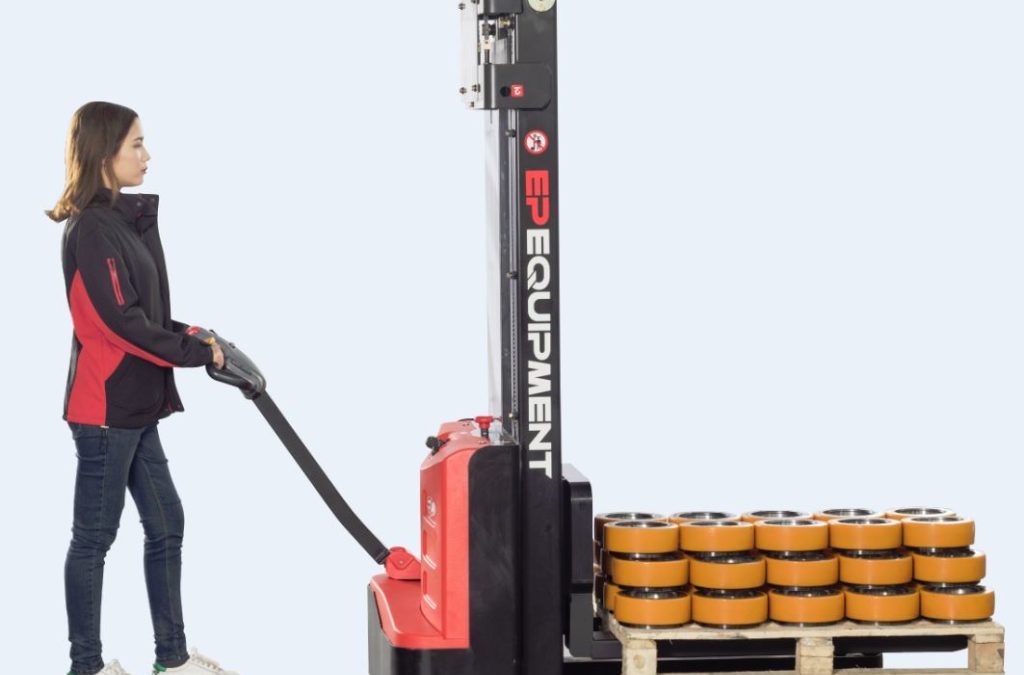Stacker machines are typically used in warehouses or on construction sites that require the heavy lifting of different stock and materials. It’s important to make sure that you select the right model for your needs, which is why our team at SHS Handling Solutions have created this useful blog.
What is a stacker machine?
Before we get into the ins and outs of stacker machines, it’s probably best that we fully understand what one is. A Stacker is a large and sturdy machine that’s used primarily for carrying materials in bulk. For example, it would be used to transport heavy bulk materials such as Limestone from A to B.
How does a stacker machine work?
A stacker machine works almost in the same way as a Forklift does. For example, both have forks that are used to lock into pallets that are holding other materials, and when locked into place the forks lift the pallets. Although this lifting motion is achieved through the use either of a winch or a hydraulic pump, this technology can be used in more than one way.
For example, in manual hydraulic stacker machines, you can raise the forks off the ground by giving an activated lever a little pump. Safe and secure with a sealant that keeps them in place, these types of models can easily get the job done.
However, there are also Winch operated pallet stacker machines. They are operated – not that surprisingly – by the turns of a winch that are attached to sturdy wire cables or special link chains. All in all, this means that that a winch operated stacker machine can lift more loads than a manual hydraulic machine. This is worth bearing in mind when picking out the stacker that best suits your warehouse. If you have stock located in tricky positions or high hourly quotas, this may be the type of stacking solution for you. Some are even fitted with special breaks that prevent an accidental lowering of the goods, keeping both you, others around you and the machine itself, safe.
In addition to this, there is another type of stacker machine that works with a table rather than a fork. To some, this may be a more ideal fit for having to shovel up larger loads as it offers a physically larger surface area where loaded items can sit. Yet, these types of stacking machines can be much more difficult to control and may take either a practised hand or an expert touch to be able to get it pointing exactly where you want it to.
Are stacker machines manual or electrical?
If you’ve already done a little bit of research on the different kinds of stacker machines, you’ve probably come to realise that overall, there are three types, manual, semi-electrical and electrical.
Manual stacker machines
You can easily tell if a stacker machine is manual. The presence of a handle or a pump is a giveaway as the driver uses this to slide the forks underneath the load and to hoist it up.
Semi-electrical stacker machines
Semi-electrical machines are not too far removed from a manual stacker machine. The main distinguishing difference between the two is the fact that the Semi-electrical machine features an electric lift. Not only does this remove some of the physical exertions for the operators, but it is also one of the more cost-effective machines to be used in a warehouse, etc.
Electrical stacker machines
It should come as no surprise that electrical stacker machines are the most expensive type of model. They’re the best option for typically heavier loads, as you’re removing any human input into operating. This makes their cost worth it if used in warehouses that are constantly dealing with the heaviest of loads.
How much is a stacker machines?
The cost of the stacker machine depends mostly on the kind of model. An electric pallet stacker is going to be much more expensive than a manual pallet stacker.
An example of this is the Manual Wrap-Over Stacker, 1.6m Lift Height, 1000kg Capacity Machine. It costs around £1,074.00 – including VAT. It has a pumping pedal that you use with your foot to lift, and an ergonomically designed handle that leads to less strain over time on the bodies of the operator – two features that mark it out as a manual machine.
The Semi Electric Wrap-Over Stacker with 1.6m lift height and 1000kg capacity is a little bit more expensive, clocking in at around £2,274.00 (including VAT).
However, this may appear much cheaper when compared to the Liftek EP Forkover Electric Stackers which costs a hefty £9,188.00 when you add on VAT.
For more information, contact SHS Handling Solutions. We have 23 years of expertise and can answer any questions.

